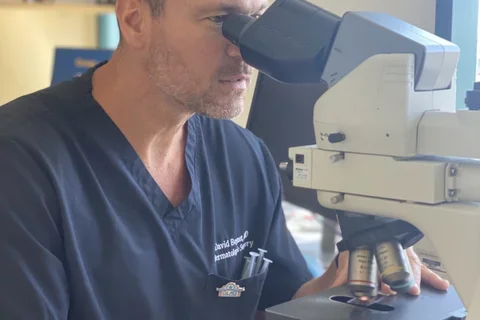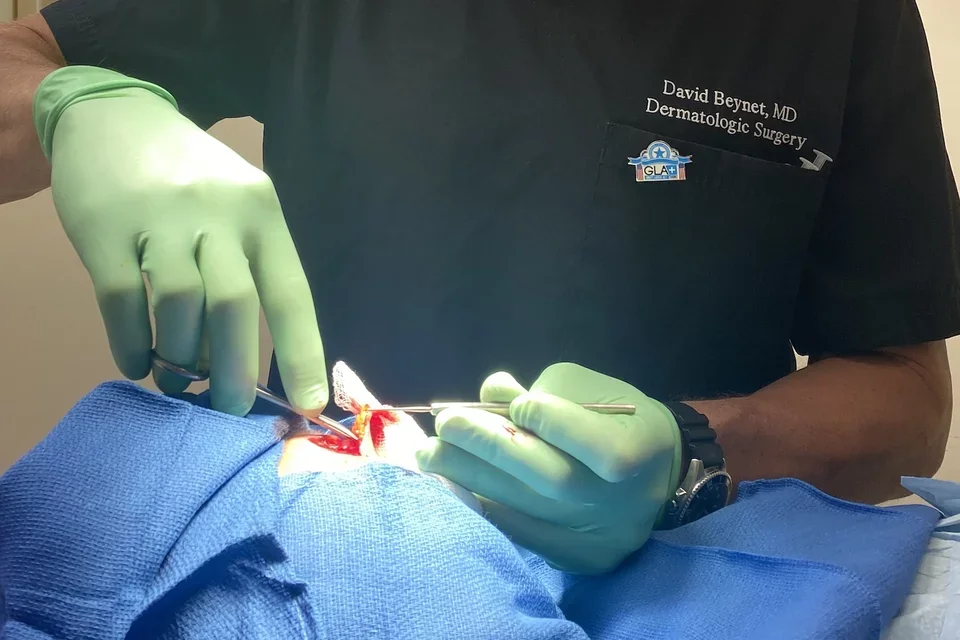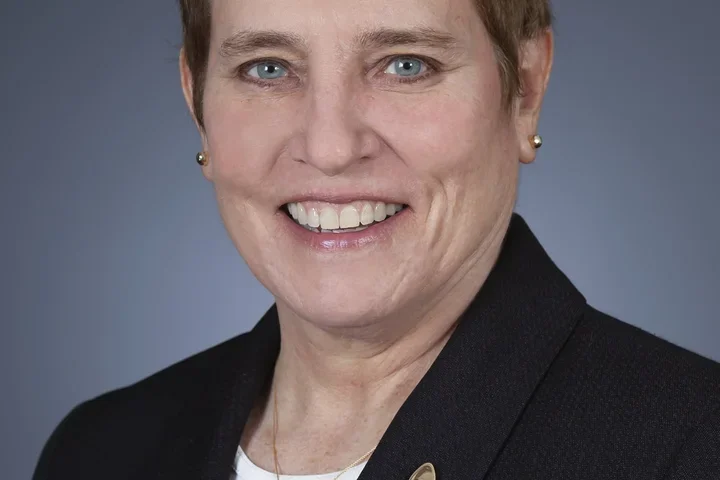What Is a Dermatologist?
Faculty Spotlight

A Day in the Life of Dr. David P. Beynet, Dermatologist at UCLA Health
UCLA dermatologist David P. Beynet, MD, MS cares for skin-cancer patients.
On any given day, he can be found surgically removing skin cancers and stitching his patients back together. If a biopsy done by a general dermatologist shows malignant cells, the patient is sent to Dr. Beynet, who surgically removes the cancer. Called a “dermatologic surgeon,” he specializes in Mohs surgery, a micrographic surgery technique named after surgeon Frederic Edward Mohs.
“Most people who have skin cancer on the head, neck, hands, and feet get Mohs surgery,” Dr. Beynet says.
“We look at the cancer under a microscope throughout the procedure to make sure we got it all, and if we didn’t, we go back and remove more.”
Mohs surgeons repeat this process until they’re confident the cancer is gone, at which point they do facial reconstructive surgery to stitch up the excisions.
“Mohs is unique in that the surgeon takes very small margins so that regular tissue is spared.”
This is essential when working on the face; surgeons don’t want to remove any unnecessary tissue, particularly from the nostril or ear.
“As a dermatologic surgeon, my job falls within a cool little niche in dermatology. It involves a mixture of pathological diagnosis, removal, and facial reconstruction.”
Dermatologic surgeons also remove skin cancers all over the body, using more traditional excisions with wider margins.
In addition to seeing patients and conducting surgery, Dr. Beynet teaches as a Clinical Professor of Dermatology/Clinical Medicine at the David Geffen School of Medicine at UCLA (DGSOM) and is also Chief of Dermatology at the Veterans Affairs (VA) Greater Los Angeles Healthcare System.
What Does a Dermatologist Do?
Dr. Beynet does specialized work within his field. General dermatologists are medical doctors who conduct skin checks and treat all types of patients with all types of skin conditions, including acne, psoriasis, rashes, and skin cancers.
Highly visible and often symptomatic, skin issues are among the most common complaints primary care doctors hear. They resolve some cases, but refer many, especially complex ones, to dermatologists.
Dr. Beynet says something interesting about dermatology is that the disease is visible to the patient.
“Patients are often more compliant with treatments and recommendations because they can see their skin issue. And seeing it bothers them in addition to the other symptoms they may have, such as itch or bleeding. That helps us take care of them.”
He illustrated his point by comparing two different issues: a bleeding mole and high blood pressure.
“You don’t see or feel high blood pressure so you might not bring it up to your doctor,” he says. “And even patients who’ve been told they have high blood pressure may forget to take their medications.”
A bleeding mole, on the other hand, will be more difficult to overlook or forget about.
“You obviously wonder what’s going on. You go see a doctor. You follow their recommendations.”
More often than not, his patients, even those who come in with severe issues, ultimately have good outcomes. He enjoys being able to remove someone’s cancer, stitch them up, and send them off to live healthy lives.
Visibility of skin lesions may help enable positive outcomes, but it can also sometimes create added challenges for dermatologists.
“Dermatology patients can also be slightly more demanding or anxious. Because their issues are so visual, they’re often more concerned than they might be about less visible things.”
Misconceptions About What Dermatologists Do
Part of understanding what a dermatologist does is understanding what they don’t do. Dr. Beynet helped us clarify a few common dermatology misconceptions.
Misconception: All dermatologists do is Botox and filler.
“I hear this all the time,” Dr. Beynet says. “While, yes, dermatologists do Botox and filler, they also treat a variety of medical diseases.”
Misconception: Dermatology is not serious medicine.
Skin diseases often have positive outcomes, but they can still be serious.
“Bad psoriasis might require medicines that need to be injected to suppress the immune system,” he says.
“Skin diseases can also be socially debilitating sometimes because patients are embarrassed of their skin or are ridiculed or stared at by others.”
Cancer is one of the main issues in dermatology, and it can be very serious.
“Skin cancers require surgery. I remove pieces of ears and noses every day. Melanoma and squamous cell skin cancer, among others, can kill patients, metastasize, and be very morbid.”
Dr. Beynet mentioned a scene from an episode of “Seinfeld” called “The Slicer,” which captures the ubiquity of this misconception. (Dermatologists love showing it at conferences.)
In the episode, the show’s eponymous star, Jerry Seinfeld, dates a dermatologist who talks about the rewards of saving lives. Jerry, who believes “skin doesn’t need a doctor,” is busy degrading her over dinner, calling her a “pimple popper,” when a patient stops by their table to thank her for saving his life. After learning the man had skin cancer, Jerry puts his foot in his mouth.
Misconception: Dermatologists and plastic surgeons do the same thing.
Functions sometimes overlap between plastic surgeons and dermatologists, especially in the cosmetic procedures they offer. However, they remain distinct medical specialties with distinct functions.
Misconception: Dermatologists and estheticians do the same thing.
Dermatologists and estheticians may treat some of the same cosmetic issues, such as acne, but overall, they perform significantly different functions. Estheticians primarily focus on skin care. Dermatologists provide advanced skin care as well as medical care.
Esthetician vs Dermatologist - What’s the Difference?
Training and Education
Estheticians are licensed skin-care professionals. Training requirements vary from state to state but often include mandatory experience hours and passing a licensing exam.
Dermatologists are physicians who complete medical school, residency programs and often fellowship training, as well as medical licensing exams.
Conditions and Treatment Types
Estheticians provide non-prescription treatments for minor cosmetic issues affecting the face and neck, such as acne, aging, and pigmentation abnormalities.
Dermatologists handle the same cosmetic issues with prescription treatments as needed, either as a first-line treatment for tough issues, such as cystic acne, or as an escalated strategy if over-the-counter treatments prove ineffective.
Dermatologists also treat medical skin conditions, including rashes and skin cancer.

What Kind of Patients See a Dermatologist
A dermatologist will often see patients for routine preventative skin checks—which are especially important for patients with a personal or family history of skin cancer—and also to examine specific issues.
Dermatologists can address both cosmetic and medical concerns, including:
- Diagnosed skin cancer
- Suspected skin cancer
- Abnormal and/or changing moles
- Rashes
- Psoriasis
- Skin changes
- Eczema
- Acne
- Cysts
How to Become a Dermatologist
To become a dermatologist, a student must complete a pre med degree, medical school, residency training in dermatology, and state licensing exams. It takes most students twelve or more years to complete the training necessary to become a dermatologist.
Dr. Beynet’s interest in dermatology developed, somewhat unexpectedly, during his medical school rotations.
“I wanted to be a cardiologist because I had a grandfather who had heart disease,” he explains. “During rotations, you get to pick a few random electives, and I chose dermatology because dermatology problems are common. I wanted to learn about something everyone asks about.”
Dermatology’s procedural emphasis surprised and delighted him—enough that he reconsidered what specialty to pursue.
“During the rotation, I realized how much dermatologists do, everything from medical dermatology to complex surgeries.”
He also liked the idea of serving a diverse patient population. People of all ages, genders, and backgrounds experience dermatologic issues.
He considered the typical dermatologist’s lifestyle an added bonus. Dermatologists rarely, if ever, get called in to handle emergencies, so their schedules tend to be more stable and predictable than a cardiologist’s, for example.
However, the predictability comes with tradeoffs. Dermatology practice may be light on emergencies, but it’s high in volume.
“Because dermatology issues are so common, we have very high patient volumes, which may lead to burnout.”
Advice for Medical Students Considering Dermatology
As dermatology is a competitive specialty, Dr. Beynet advises aspiring dermatologists to get experience through rotations or research projects as early as possible.
“It’s a small field, so getting involved early is helpful for making connections and also learning what experience you need to be a strong candidate for the programs you’re interested in.”
He shared a few foundational qualities that make someone a strong candidate for dermatology:
- Skill and interest in working with their hands, as the field is very procedural
- A personable and compassionate nature well suited to communicating with anxious patients
- Interest in the clinical, pathological, and surgical aspects of patient care
Dermatology Subspecialties Students May Consider
- Micrographic Dermatologic Surgery/Mohs Surgery
- Dermatopathology
- Pediatric Dermatology
- Cosmetic Dermatology
How Much Do Dermatologists Make?
According to the United States Bureau of Labor Statistics compensation data, the mean annual dermatologist salary in the U.S. is $327,650.
Summer Sun Safety Month
Summer Sun Safety Month, which takes place every August, reminds people about important, yet easy, steps they can take to protect themselves from sun damage and reduce their risk of developing skin cancer. In honor of the awareness month, Dr. Beynet provided some practical sun-safety tips people can follow year-round.
Avoid sun during peak hours (10 AM to 4 PM).
If you do go outside...
- Find shade
- Use sunscreen with an SPF (sun protection factor) of 30+ and that provides broad-spectrum protection from UVA / UVB rays
- Reapply sunscreen every 2 hours, or more often if you’re sweating, swimming, or engaging in water sports
“In the summer, you’re just going to get more sun naturally. I always tell people to go out, have fun, and enjoy life, but to take preventive care as best they can.”
He tells people to keep batches of sunscreen in different places, such as the car, purse, gym bag, etc.
“This ensures you’ll always have some with you.”
Remember that you can still get a sunburn, even if it's overcast.
Remember that sunglasses protect your eyes—not your skin.
“When you’re wearing sunglasses, you sometimes don’t realize exactly how sunny it is. Keep that in mind so you don’t forget to wear or reapply your sunscreen. This doesn’t mean you shouldn’t wear sunglasses though. Sunglasses should be worn to protect the eyes from the harmful UV rays as well.”
Do regular skin checks to catch any problems early.
“If you have a personal or family history of skin cancer, get regular full-body skin checks from a dermatologist,” he says.
He also advises everyone to do self-exams in the mirror, or to have friends or loved ones examine them, and to see a dermatologist if they notice anything suspicious, such as changing or asymmetrical moles.
“Early detection is key for having positive skin-cancer outcomes, particularly with melanoma.”



